warning AUDI A8 2016 Owners Manual
[x] Cancel search | Manufacturer: AUDI, Model Year: 2016, Model line: A8, Model: AUDI A8 2016Pages: 302, PDF Size: 75.68 MB
Page 235 of 302

will be damaged and will then have to be re
placed.
Battery charging
Starting the engine requires a well charged bat
tery.
Fig. 203 Engine co mpa rtment: connectors fo r a c harger
and jump start cables
Always read and heed all WARNINGS below
~ &. and
¢ A in Working on the battery on
page 232.
• Switch off the ignition and all electrical con
sumers .
• Make sure the area is well ventilated when you
charge the battery.
• Open the engine hood
~ page 220.
• Remove the cover (D by pressing on the arrow
¢ fig . 203.
• Open the cover @on the positive terminal.
• Connect the charger connectors according to
the instructions to the
jump start bolts. (Bolts
under the red cover= "positive" , Bolts with hex
head
= "negat ive").
• Only now plug the mains lead for the charging
equipment into the wall outlet and turn it on
¢&,, .
• Make sure the charging rate is not over
30 amps/14.8 Volt.
• When the battery is fully charged: Turn the
charging equipment off and remove the mains
lead from the wall outlet .
• Now remove the clamps for the charging equip-
ment.
~ • Close the red cover on the positive pole. 0
~ • Close the hood~ page 221.
rl I.Cl U"I
rl I.Cl rl
Checking and Filling
A discharged battery can freeze at temperatures
of only 32 F
0 (0 °C). Allow a frozen battery to
thaw completely before attempting to charge it
¢ &. However , we recommend not using a
thawed battery again because the battery casing can be cracked due to ice formation and can leak
battery acid.
Battery charging (Maximum charging rate of
30 amps/14.8 Volt)
When charging at low voltages (e.g . w ith a trick
le charger),
the battery cables do not have to be
disconnected first. The battery caps should
not
be opened when charging a battery.
It is not necessary to remove the battery from
the luggage compartment, and it is also not nec
essary to disconnect the cables .
Fast charging the battery (charging rate
above 14.8 Volts)
For technical reasons do not use a battery charg
er that uses voltage greater than 14.8 Volts to
charge your vehicle's battery.
.&_ WARNING
Charging a battery can be dangerous.
- Always follow the operating instructions
provided by the battery charger manufactur
e r when charging your battery.
- Never charge a frozen battery. It may ex
p lode because of gas trapped in the ice. Al
low a frozen battery to thaw out first.
- Do not reuse batteries which were frozen.
The battery housing may have cracked and
weakened when the battery froze.
- Charge the battery in a well ventilated area.
Keep away from open flame or electrical
spark. Do not smoke. Hydrogen gas generat
ed by the battery is explosive.
- To reduce the danger of explosion, never
connect or disconnect charger cables while
the charger is operating.
- Fast charging a battery is dangerous and
should only be attempted by a competent
technician with the proper equipment.
- Battery acid that may spill during charging
should be washed off with a so lution of
233
Page 236 of 302
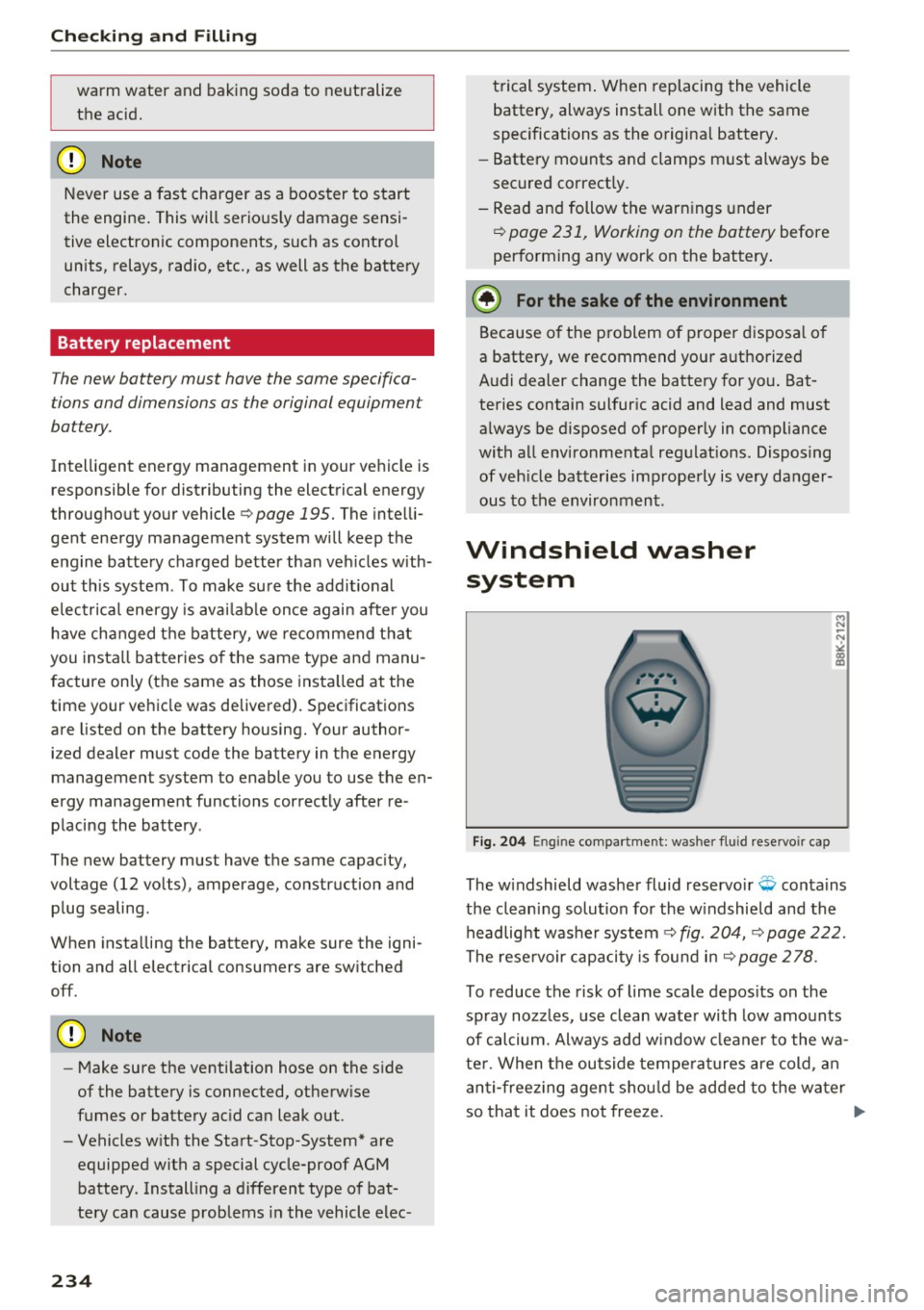
Check ing and F illing
warm water and baking soda to neutralize
the acid.
CD Note
Never use a fast charger as a booster to start
the engine . This will serious ly damage sensi
tive electronic components, such as control
units, relays, radio, etc., as well as the battery
charger.
Battery replacement
T he new battery must have the same specifica
t ions and dimensions as the original equipmen t
bat tery.
Int elli g ent en ergy managem ent in your vehicle is
responsible for distributing the electrical energy
throughout your vehicle
r=> page 195. The intelli
gent energy management system will keep the
engine battery charged better than veh icles w ith
out this system . To make sure the addit ional
e lectrical energy is avai lab le once again after you
have changed the battery, we recommend that
you install batteries of the same type and manu facture on ly (the same as those installed at the
time your vehicle was delivered). Specifications
are listed on the battery housing. Your author
i z ed dealer must code the battery in the energy
management system to enable you to use the en
ergy management functions correctly after re
placing the battery .
The new battery must have the same capacity,
voltage (12 volts) , amperage, construction and
plug sealing .
When installing the battery, make sure the igni
tion and all electrical consumers are sw itched
off.
CD Note
- Make sure the ventilation hose on the s ide
of the battery is connected, otherw ise
fumes or battery ac id can leak out.
- Vehicles with the Start-Stop-System* are equipped with a special cycle-proof AGM battery . Installing a d ifferent type of bat
tery can cause problems in the vehicle elec -
234
trical system. When replacing the vehicle
battery, always install one with the same
specifications as the original battery .
- Battery mounts and clamps m ust always be
secured correctly.
- Read and follow the warnings under
¢ page 231, Working on the battery before
performing any work on the battery .
@ For the sake of the environment
Because of the p roblem of proper disposal of
a battery, we recommend your authorized
A udi dealer change the battery for you . Bat
teries contain sulfur ic acid and lead and must
a lways be disposed of properly in compliance
with all environmental regulations . Disposing
of veh icle batteries improperly is very danger
ous to the environment .
Windshield washer
system
Fig. 204 En gin e compa rt ment: washer fluid rese rvoir cap
The w indshield washer fluid reservo ir Q conta ins
the cleaning solution for the w indshield and the
headlight washe r system ¢
fig. 204, ¢ page 222.
The reservoir capacity is found in
r=> page 2 78 .
To reduce the risk of lime scale depos its on the
spray nozzles, use clean water with low amounts
of calcium. Always add w indow cleaner to the wa
ter . When the outside temperat ures are cold , an
anti-freez ing agent shou ld be added to the water
so that it does not freeze. ..,.
Page 246 of 302
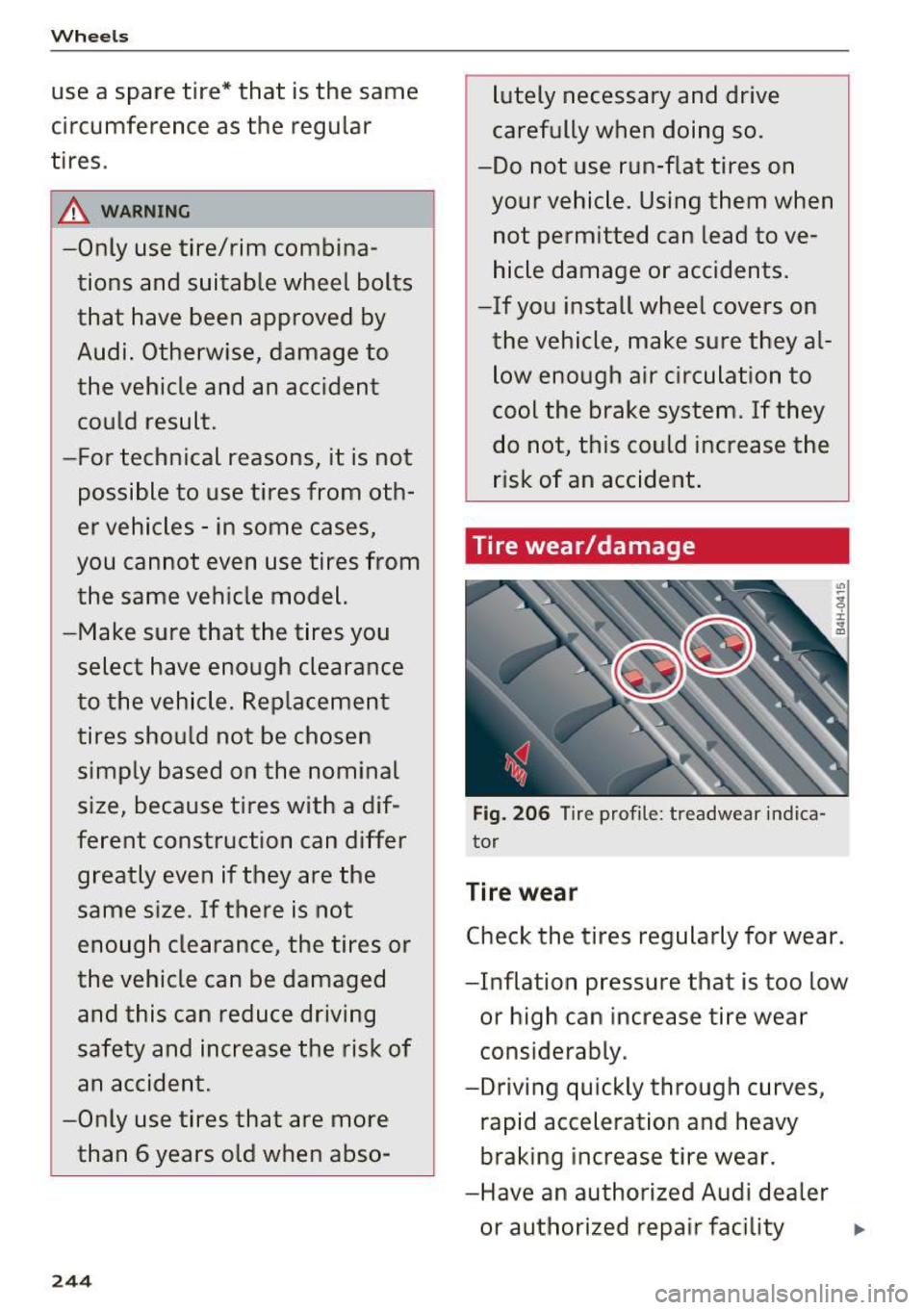
Wheels
use a spare tire* that is the same
circumference as the regular
tires .
A WARNING
-Only use tire/rim combina
tions and suitable wheel bolts
that have been approved by
Audi. Otherwise, damage to
the vehicle and an accident
could result.
-For technical reasons, it is not
possible to use tires from oth
er vehicles -in some cases,
you cannot even use tires from the same vehicle model.
-Make sure that the tires you select have enough clearance
to the vehicle. Replacement
tires should not be chosen
simply based on the nominal
size, because tires with a dif
ferent construction can differ
greatly even if they are the
same size. If there is not
enough clearance, the tires or
the vehicle can be damaged and this can reduce driving
safety and increase the risk of an accident.
-Only use tires that are more than 6 years old when abso-
244
lutely necessary and drive
carefully when doing so.
-Do not use run-flat tires on
your vehicle. Using them when not permitted can lead to ve
hicle damage or accidents.
-If you install wheel covers on
the vehicle, make sure they al
low enough air circulation to
cool the brake system. If they
do not, this could increase the
risk of an accident.
Tire wear/damage
Fig. 206 Tire profile: treadwear indica
tor
Tire wear
Check the tires regularly for wear.
-Inflation pressure that is too low or high can increase tire wear
considerably.
-Driving quickly through curves, rapid acceleration and heavy
braking increase tire wear.
-Have an authorized Audi dealer or authorized repair facility
i.
Page 247 of 302
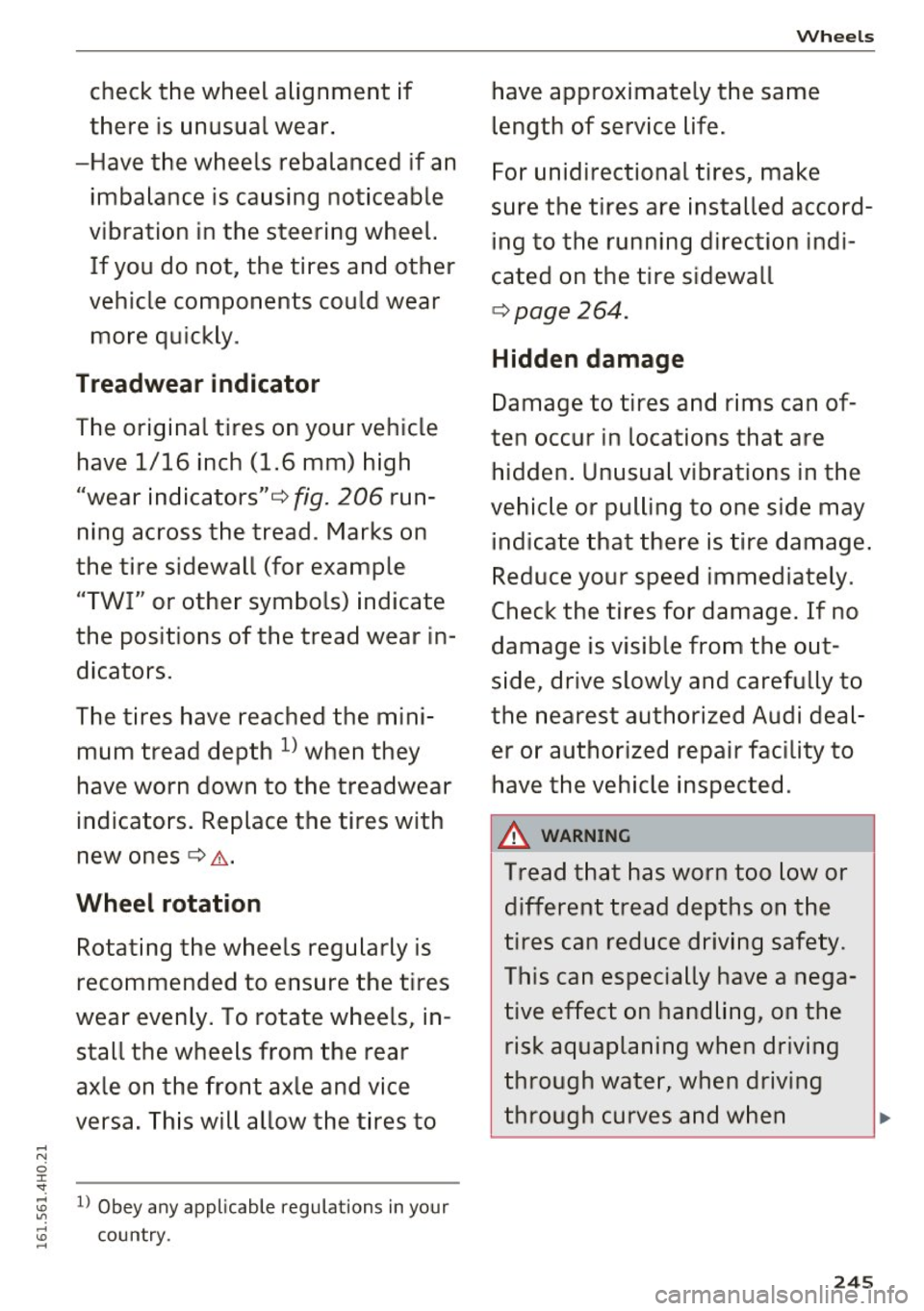
Wheels
check the wheel alignment if have approximately the same
there is unusual wear. length of service life.
-Have the wheels rebalanced if an
For unidirectional tires, make
imbalance is causing noticeable
sure the tires are installed accord-
vibration in the steering wheel. ing to the running direction indi-
If you do not, the tires and other cated on the tire sidewall
vehicle components could wear
¢ page 264.
more quickly.
Hidden damage
Treadwear indicator
Damage to tires and rims can of-
The original tires on your vehicle ten occur in locations that are
have 1/16 inch (1.6 mm) high hidden. Unusual vibrations in the
"wear indicators" ¢
fig. 206 run-
vehicle or pulling to one side may
ning across the tread . Marks on
indicate that there is tire damage.
the tire sidewall (for example Reduce your speed immediately.
"TWI" or other symbols) indicate
Check the tires for damage. If no
the positions of the tread wear in- damage is visible from the out-
dicators. side, drive slowly and carefully to
The tires have reached the mini- the nearest authorized Audi deal-
mum tread depth
l) when they er or authorized
repair facility to
have worn down to the treadwear have the vehicle inspected
.
indicators. Replace the tires with
_& WARNING
new ones ¢&. -
Tread that has worn too low or
Wheel rotation different tread depths on the
Rotating the wheels regularly is tires can reduce driving safety.
recommended to ensure the tires This
can especially have a nega-
wear evenly. To rotate wheels, in- tive effect on handling, on the
stall the wheels from the rear risk aquaplaning when driving
axle on the front axle and vice through water, when driving
versa. This will allow the tires to through curves and when
..
.... N ci :c ": .... l) Obey
any applicable regulations in your '° "? .... country. '° ....
245
Page 248 of 302
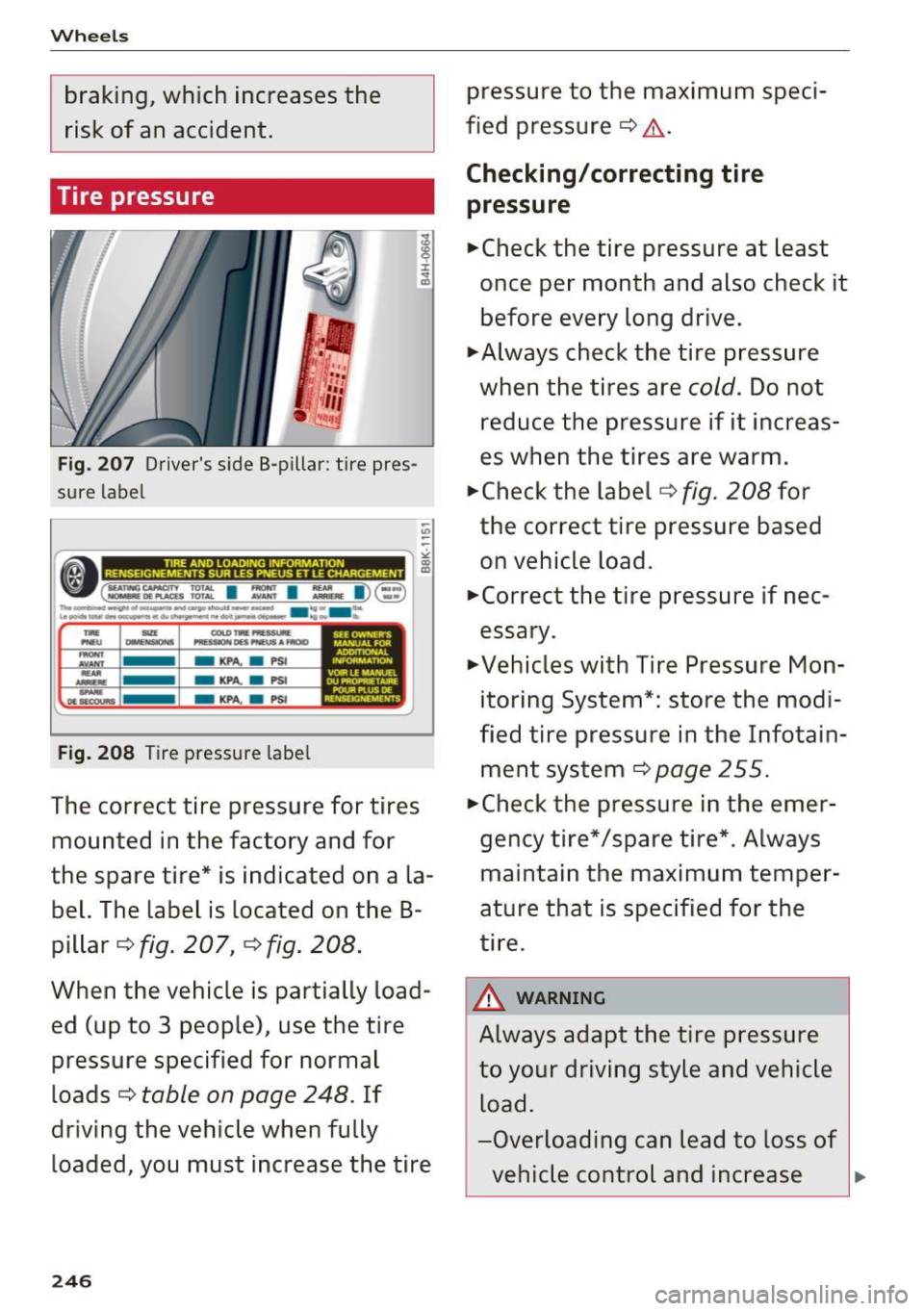
Wheels
braking, which increases the
risk of an accident.
Tire pressure
pressure to the maximum speci
fied pressure
c:::> ,&. .
Checking/correcting tire
pressure
f •Check the tire pressure at least
:r
..; once per month and also check it
Fig. 207 Driver's side B-pillar : tire pres
sure label
:;;
-(~. -----~ ,~
( :=~ ~~:: I ~ I :. I)( ::-) n.,_.....,__.o1___.. .. -vo.._.......... • ... _ ... le~---~--.....,,_.,-'"-,............ ....,, .
lllf """ PNW 07:0lifla.l
-KPA. a PSI
- KPA.
a PSl
- KPA.
a PSl
Fig. 208 Tire pressure label
SEE OWNEJll"S MAMJAI.FOR
AODmOHAI.
INIFOAMATlON
VOOIUMANUEl.
DUNIOl'N:iTA.IRE POUR
P'l. US DE HTS J
The correct tire pressure for tires
mounted in the factory and for
the spare tire* is indicated on a la
bel. The label is located on the B
pillar
c:> fig. 207, c> fig. 208.
When the vehicle is partially load
ed (up to 3 people), use the tire
pressure specified for normal
loads
c:> table on page 248. If
driving the vehicle when fully loaded, you must increase the tire
246
before every long drive.
•Always check the tire pressure
when the tires are
cold. Do not
reduce the pressure if it increas
es when the tires are warm.
•Check the label
c:> fig. 208 for
the correct tire pressure based
on vehicle load.
•Correct the tire pressure if nec
essary.
•Vehicles with Tire Pressure Mon
itoring System*: store the modi
fied tire pressure in the Infotain ment system
c:> page 255.
•Check the pressure in the emer
gency tire*/spare tire*. Always
maintain the maximum temper
ature that is specified for the
tire.
A WARNING ~
Always adapt the tire pressure
to your driving style and vehicle load.
-Overloading can lead to loss of
vehicle control and increase
Page 250 of 302

Wheels
Tire pressure
Model/ Tire designation Normal load Maximum load
Engine (up
to
2*/3 people)a>
front rear front rear
PSI kPA PSI kPA PSI kPA PSI kPA
A8/A8 L : 235/55 Rl8 104H
35 240 32 220 36 250 38 260
3.0L
255/45 Rl9 104H 35 2
4 0
32 22 0 36 25 0 38 2 60
6 cylinders 265/40 R20 104H 35 24 0 32 220 36 250 38 260
265/40 R20 104V 33 2
30 32 22 0
33 2
30
35 240
275/35 R21 103Y
XL 35 240 32 220 36 250 35 240
A8/A8 L: 235/55 Rl8 104H 35 240 32 22
0
38 26
0
38 26
0
4.0L
255/45 Rl9 104H 35 240 32 220 38 260 38 260
8 cylinders 265/40 R20 104H 35 240
32 220
38 260
38 2
60
265/40 R20 104Y 33 230 32 220 35 240
35 240
275/35 R21 103V XL 35 240 32 2 20 38 260
38 260
AB L: 265/40 R20 104Y 35 240 32 220 36 250 35 240
6.3L
255/45 Rl9 104H 36 25 0 32 2 20
39 270 38 260
12 cylin-265/40 R20 104H 36 25
0 32 220 39 270 38 260
ders
275/35 R21 103Y XL 35 24 0 32 220 36 250 35 240
58: 265/40 R20 104Y 36 250 32 22 0 39 27
0
38 260
4.0L 265/35 R21 101 Y 39 270 35 240 44 300 42 290
8 cylinders 275/35 R21 103V XL 39 27
0
35 2
4 0 4 4
300 42
290
a) Vehicles with 4 seating positions: two people in the front, Vehicles with S seating
positions:
two people in the front , one person in the rear
A WARNING
Please note the important safe
ty precautions regarding tire
pressure ¢
page 246 and load
limits¢
page 248.
Tires and vehicle load limits
There are limits to the amount of
load or weight that any vehicle
and any tire can carry. A vehicle
that is overloaded will not handle
well and is more difficult to stop.
248
Overloading can not only lead to
loss of vehicle control, but can al
so damage important parts of the
vehicle and can lead to sudden
tire failure, including a blowout
and sudden deflation that can
cause the vehicle to crash.
Your safety and that of your pas
sengers also depends on making
sure that load limits are not ex
ceeded . Vehicle load includes ev
erybody and everything in and on
the vehicle. These load limits are ..,.
Page 251 of 302
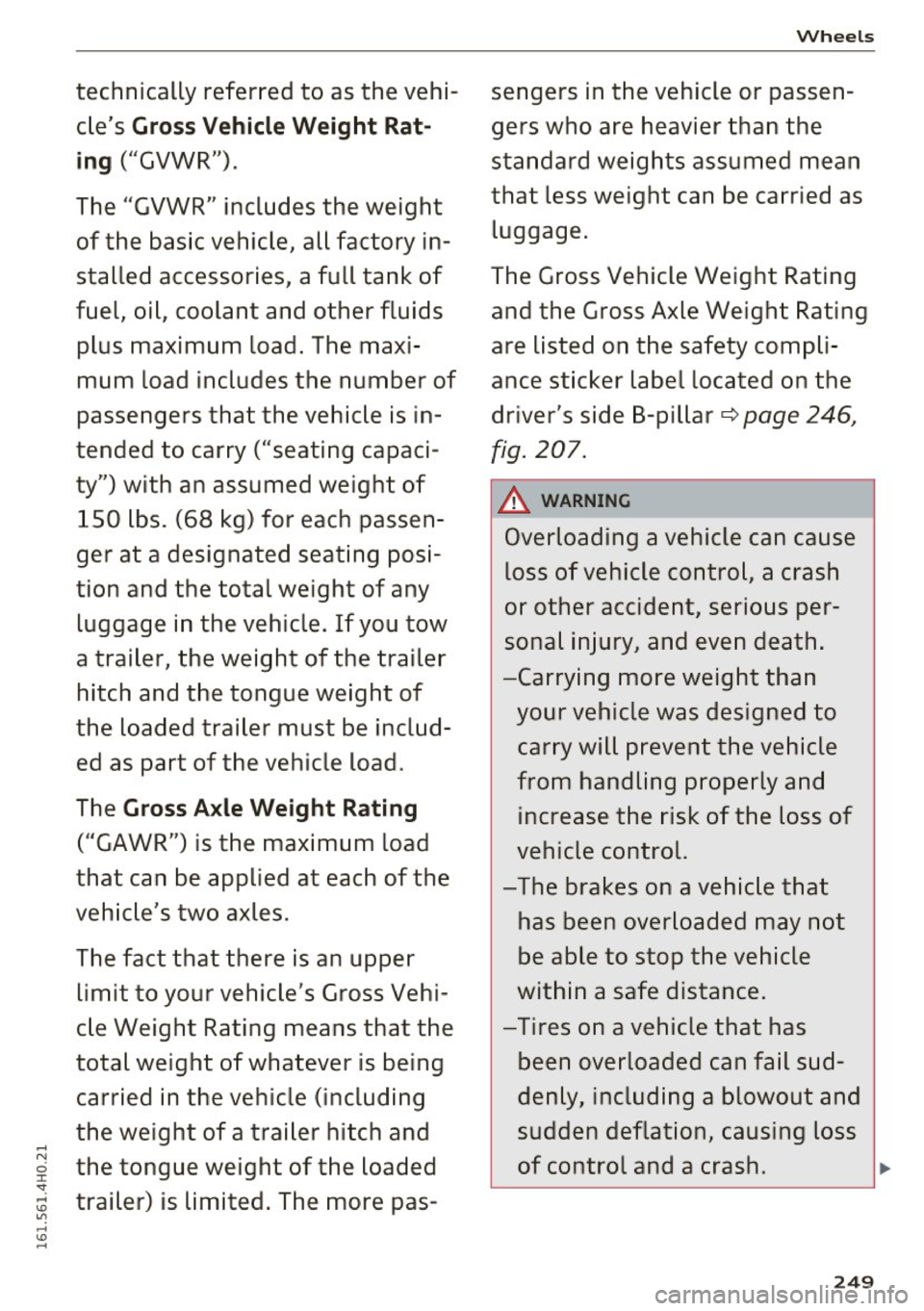
Wheels
technically referred to as the vehi- sengers in the vehicle or passen-cle's
Gross Vehicle Weight Rat-gers who are heavier than the
ing ("GVWR"). standard weights assumed mean
The "GVWR" includes the weight that less weight can be carried as
of the basic vehicle, all factory in-luggage.
stalled accessories, a full tank of The Gross Vehicle Weight Rating
fuel, oil, coolant and other fluids and the Gross Axle Weight Rating
plus maximum load. The maxi- are listed on the safety compli-
mum load includes the number of ance sticker label located on the
passengers that the vehicle is in- driver's side B-pillar
c::::> page 246,
tended to carry ("seating capaci-fig. 207.
ty") with an assumed weight of
.&_ WARNING
150 lbs . (68 kg) for each passen-
Overloading a vehicle can cause
ger at a designated seating posi-
loss of vehicle control, a crash
tion and the total weight of any
or other accident, serious per-
luggage in the vehicle. If you tow
sonal injury, and even death.
a trailer, the weight of the trailer
-Carrying more weight than
hitch and the tongue weight of
your vehicle was designed to
the loaded trailer must be includ-
carry will prevent the vehicle
ed as part of the vehicle load.
from handling properly and
The
Gross Axle Weight Rating increase the risk of the loss of
("GAWR") is the maximum load vehicle control.
that can be applied at each of the -The brakes on a vehicle that
vehicle's two axles. has been overloaded may not
The fact that there is an upper be able to stop
the vehicle
limit to your vehicle's Gross Vehi- within a safe distance.
cle Weight Rating means that the -Tires
on a vehicle that has
total weight of whatever is being been overloaded can fail sud-
carried in the vehicle (including denly, including a blowout and
.... the weight of a trailer hitch and sudden deflation, causing loss
N the tongue weight of the loaded of control and a crash. ci ... :c ": trailer) is limited. The more pas-....
'° "? ....
'° ....
249
Page 253 of 302
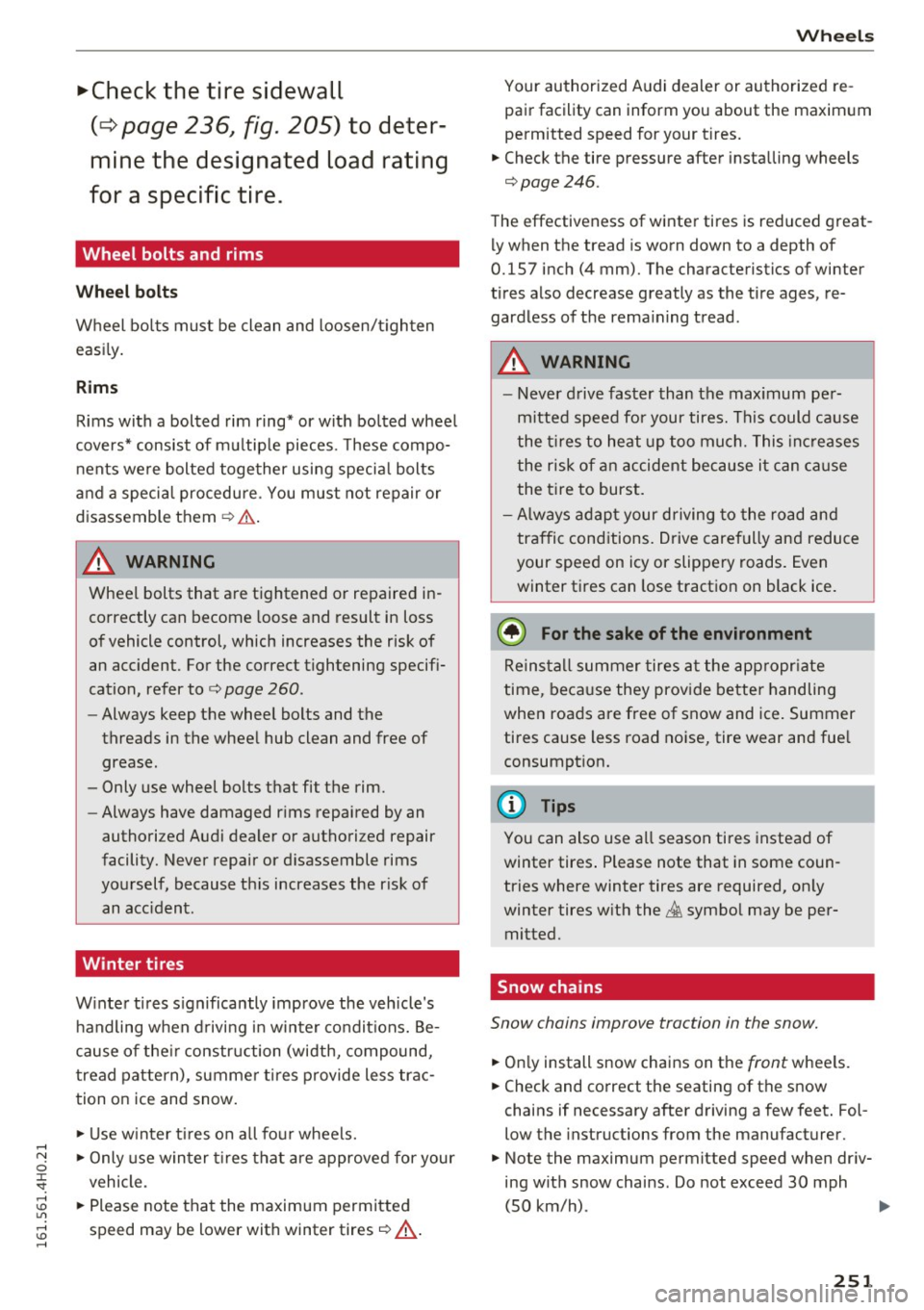
.,.Che ck th e tir e s idewall
(c:::> page 2 3 6, fig. 205 ) to deter
min e th e des ig nated load r atin g
for a spec ific tir e.
Wheel bolts and rims
Wheel bolts
Wheel bolts must be clean and loosen/t ighten
easi ly.
Rims
R ims with a bolted rim ring* or with bolted wheel
covers* consist of m ultip le pieces. These compo
n ents were bolted toge ther using specia l bolts
a nd a specia l procedu re. You must not repair or
disassemble them¢
A.
A WARNING
Wheel bolts that are t ightened or repaired in
co rrectly can become loose and result in loss
of vehicle control, which increases the risk of
an acc ident. For the correct tightening specifi
cation, refer to¢
page 260.
-Always keep the wheel bolts and the
threads in the whee l hub clean and free of
grease.
- Only use wheel bolts that fit the rim.
- Always have damaged r ims repaired by an
authorized Audi dealer or authorized repair
facility. Never repair or d isassemble rims
yourself, because th is increases the r isk of
an acc ident .
Winter tires
W inte r tires s ignificantly improve the vehicle's
h andling when d rivi ng in winter condit ions. Be
cause of the ir constr uction (width, compound,
t read pattern), summe r ti res provide less trac
tion on ice and snow.
"'U se winte r tir es on all four wheels.
"' Only use winter t ires that a re approved for your
vehicle.
"' Please note that the maximum permitted
speed may be lower with winter tires
¢ &, .
Wh eel s
Your authorized A udi dealer or authorized re
pair facility can inform you about the maximum
permitted speed for your tires.
"' Check the tire pressure after insta lling wheels
¢page 246.
The effectiveness of winter tires is reduced great
ly when the tread is worn down to a depth of
0.157 inch (4 mm). The characteristics of winter
tires also decrease greatly as the tire ages, re gardless of the rema ining t read .
A WARNING
'---
-Never d rive faster than the max imum pe r
mitted speed for your tires. This could ca use
the t ires to heat up too mu ch. This in cr eases
the r isk of an accident because it can ca use
the t ire to burst.
- Always adapt your driving to the road and
traffic cond itions. Drive carefully an d reduce
your speed on icy or slippery roads. Even
winter t ires can lose tract ion on black ice.
@ For the sake of the environment
Reinsta ll summer tires a t the app ropr iate
time, beca use they prov ide bette r handling
when roads are free of snow and ice . Summer
tires cause less road noise, tire wear and fue l
consumpt ion.
(D Tips
You can also use all season tires instead of
winter tires . Please note that in some coun
tries where winter tires are required, on ly
winter tires w ith the
& symbo l may be per
mitted.
Snow chains
Snow chains improve traction in the snow.
"' On ly install snow chains on the front wheels.
"' Check and co rrect the seating of the snow
chains if necessary after driving a few feet. Fol
low the instructions from the manufacturer.
"' Note the maximum permitted speed when dr iv
ing with snow chains. Do not exceed 30 mph
(SO km/h) . ...
251
Page 254 of 302

Wheels
Snow chains not only improve the driving in win
ter road conditions, but also the broking.
Use of snow cha ins is o nly pe rm itted with certain
r im/t ire combinations due to tec hni cal reasons.
Check with an authorized Audi dealer or author
ized repair faci lity to see if yo u may use snow
cha ins .
The snow c ha ins must have
low-profile lin ks and
m ust not be thicker than 0 .4 inch (10.S mm), in
cluding the lock.
You mus t remove the c hains whe n driving on
roads that are
free of snow. When roads are free
of snow, snow c hains can impair handling and
damage the tires, and the chains wi ll quickly be
destroyed .
_& WARNING
Using inco rrect snow chains or insta lling snow
chains incorrectly can result in loss of vehicle
cont rol, which inc reases the risk of an acc i
dent .
{CT) Note
-Snow cha ins can damage the rims/wheel
covers* if the chains come into d irect con
tact with them . Remove the wheel cove rs*
first. Use coated snow chai ns.
- Using snow chains that add more than 0.4
inch (10.5 mm) of he ight can severely dam
age the wheel hous ings and other vehicle
components.
- Do not i nstall and use snow chai ns if there is
a malfunct ion in the adaptive air suspen
s io n, because the vehicle he igh t will be very
l ow. If you drive wi th snow ch ains anyw ay,
the wheel ho usings and other vehi cle com
ponen ts can be severely damaged .
(D Tips
When using snow chains, it m ay be useful t o
sw itch on sport mo de
¢page 192.
Low aspect ratio tires
Your Aud i is factory-equipped with low aspect ra
tio tires . These ti res have been tho roughly tested
252
and been sele cted specifica lly for your mode l for
their superb performance, road fee l and hand ling
u nder a var iety of dr iv ing cond it ions. Ask your au
thori zed Audi dea ler fo r more details.
The low aspect rat io o f these tires is indica ted by
a n umera l of
55 or less in the tire's size designa
t ion . The n umera l represents the ratio of the
tire's sidewall height in relation to its tread width
expressed in percentage. Convent iona l tires have
a height/width ratio of 60 or more .
The performance of low-aspect-ratio tires is par
t ic ularly sensitive to improper inflation pres
sure.
It is the refore important that low aspect
ratio tire s are inflated to the specified pressure
and that the inflation pressur e is regularly
checked and maintained . T ir e pressures should
b e c hec ked at l east on ce a month and alway s
befor e a long trip
¢ page 246.
What you can do to avoid tire and rim
damage
Low aspect ratio tires can be damaged more eas i
l y by impact with potholes, curbs, gullies or
ridges on the road, particularly if the tire is un
derinflated.
In orde r to mi nimi ze the occur rence of impact
dam age to the tires of yo ur vehicle, we recom
mend tha t you observe the following preca u
tions:
- Always ma intain recommended i nflation pres
sures. Check yo ur tir e pressure eve ry 2,0 00
m iles (3,000 km) and add air if necessary .
- Dr ive ca refully on roads w ith potholes, deep
gullies o r ridges. The impac t from dr iv ing
through or over such obstacles can damage
your tires. Impact with a curb may a lso ca use
damage to your ti res.
-After any impact, immediate ly inspect you r
tires or have them inspected by the nearest au
thorized A udi dealer. Replace a damaged tire as
soon as possible.
- Inspect your tires every 2,000 mi les (3,000 km)
for damage and wear. Damage is not always
easy to see . Damage can lead to loss of air and
underinflation, wh ich could eventually cause
tire fa ilure . If you be lieve that a tire may have .,.
Page 255 of 302
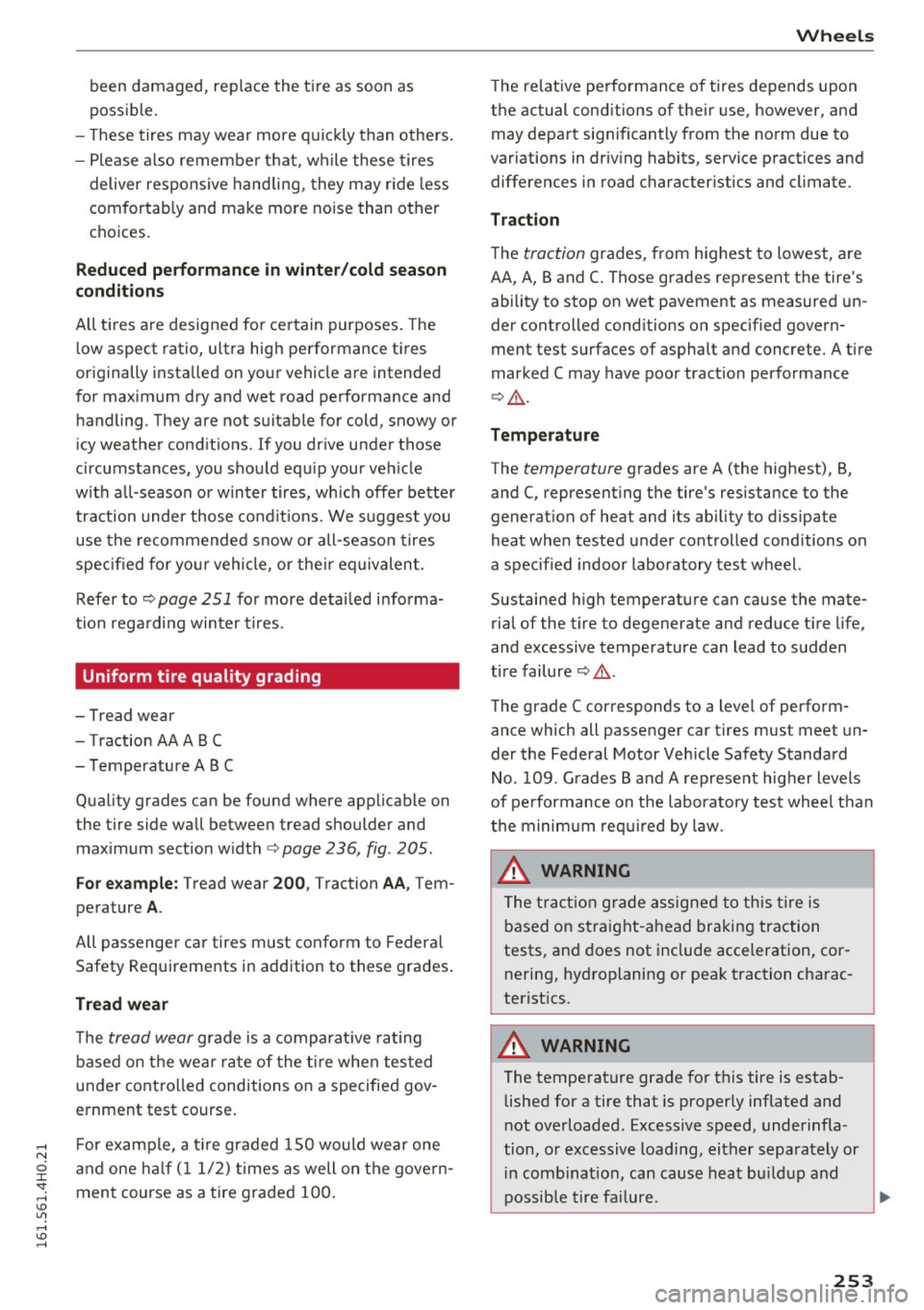
been damaged, replace the t ire as soon as
possible .
- T hese tires may wear more q uickly than others.
- Please a lso remembe r th at, while these tires
deliver responsive handling, they may r ide less
comfortab ly and make more noise than other
choices .
Reduc ed performance in wint er/ cold sea son
condit ions
All ti res are designed fo r ce rtain purposes. The
l ow aspect ratio, ultra high performance tires
originally insta lled on your vehicle are intended
for maximum dry and wet road performance and handling . They are not suitable for cold, snowy or
i cy weather cond it ions. If you dr ive under those
circumstances, you should equ ip your vehicle
with a ll-season or winter tires, wh ich offer better
traction under those condit ions. We suggest you
use the recommended snow or all-season tires
specified for yo ur vehicle, or the ir eq uivalent.
Refer to
c::;, page 251 for more detai led informa
tion rega rding winter tires.
Uniform tire quality grading
- T read wear
- T raction AA A B C
- Temperature ABC
Quality grades can be found where applicable on
the tire side wall between tread shoulder and maximum sect ion w idth
c::> page 236, fig . 205.
For e xample: Tread wear 200 , Traction AA , Tem
perature A.
All passenger car tires m ust conform to Federa l
Safety Requirements in addition to these grades .
Tread wea r
The
tread wear grade is a comparat ive rating
based on the wear rate of the t ire when tes ted
under cont ro lled conditions on a specified gov
ernment test course.
F or examp le, a t ire graded
150 would wear one
and one h alf
(1 1/2) times as well on the govern
ment course as a tire g raded
100 .
Wh eel s
The re lat ive pe rformance of tires depends upon
the actual cond itions of their use, however, and
may depart significantly from the norm due to
variations in driv ing habits, service practices and
differences in road character istics and cl imate.
T raction
The
traction grades, from highest to lowest, are
AA, A, Band
C. Those grades rep resent the tire's
ability to stop on wet pavement as measured un
der controlled cond itions on specified govern
ment test surfaces of asphalt and concrete. A tire
marked C may have poor traction performance
c::;, .&_ .
Te mperature
The
temperature grades are A (the highest), B,
and C, representing the tire 's resistance to the
generat ion of heat and its ability to dissipate
heat when tested under controlled conditions on
a specified indoor laboratory test wheel.
Sustained h igh temperature can cause the mate
rial of the tire to degenerate and reduce tire life,
and excessive temperature can lead to sudden
tire failure c::;, .&. .
The grade C corresponds to a level of perform
ance which all passenger car tires must meet un
der the Federal Motor Vehicle Safety Standard
No.
109 . Grades Band A represent higher levels
of pe rformance on the laboratory test wheel than
the minim um req uir ed by law.
A WARNING
-
The t ract io n grade assigned to this t ire is
based on straight -ahead braking traction
tests, and does not include acceleration, co r
nering, hydroplaning or peak traction charac
terist ics.
A WARNING
-The temperature grade for this tire is estab
lished for a tire that is properly inflated and
not overloaded. Excessive speed, underinfla
tion, or excessive loading, either separately or
i n comb inat ion, can cause heat bu ildup and
-
possib le tire fai lure. ~
253